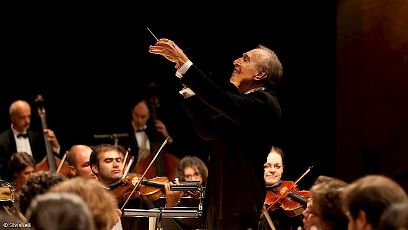Ouverture Spirituelle - Mozart & Schubert (Claudio Abbado) [2016]
Ouverture Spirituelle - Mozart & Schubert (Claudio Abbado) [2016]

1. Mozart: Mass in C minor, K. 139 "Waisenhausmesse" (Orphanage Mass)
Kyrie, Adagio
Gloria
Credo
Sanctus, Adagio
Benedictus
Agnus Dei, Andante
Dona
2. Schubert: Mass in E flat major, D. 950
Kyrie
Gloria
Domine Deus
Quoniam tu solus sanctus
Cum sancto Spiritu in gloria
Credo
Et incarnatus est
Et resurrexit tertia die
Sanctus
Osanna in excel...
Benedictus
Angus Dei
Dona nobis pacem
Agnus Dei
Dona nobis pacem
Rachel Harnisch (Sopran)
Roberta Invernizzi (Sopran)
Sara Mingardo (Mezzosopran)
Javier Camarena (Tenor)
Paolo Fanale (Tenor)
Alex Esposito (Bass)
Arnold Schoenberg Chor
Orchestra Mozart Bologna
Claudio Abbado (Conductor)
Recorded at the Salzburg Festival in the Haus für Mozart.
25.12.2016. TV Broadcast.
During the earlier part of his life in Salzburg, Mozart found few opportunities to compose large- scale sacred works. Particularly after the accession of Archbishop Hieronymous Colloredo in 1772, the requirement was for short masses (missa brevae), in accordance with the reforms instituted by the Archbishop. The largest (and indeed first complete mass setting by Mozart) was in fact composed not for Salzburg, but for the dedication of the new Orphanage Church (Waisenhaus) in Vienna on 7 December 1768. The work was directed by the twelve- year old Mozart himself before a distinguished gathering that included the imperial court. In keeping with the grandeur of the occasion this C Minor Mass is a full-scale missa solemnis (solemn mass) that includes three trombones in the scoring (characteristic of such works) along with four trumpets and timpani in addition to the customary pair of oboes and strings. While most of the mass is in fact in C Major, it does open with an extraordinarily dramatic gesture in C Minor that immediately arrests attention. The remainder of the work is a juxtaposition of the old "learned" style of former Viennese church composers such as J.J. Fux (the fugues at the end of the Gloria and Credo) and, particularly in the solo sections, the modern galant style Mozart had become familiar with in the works of Johann Christian Bach he heard in London. If the two styles do not always sit easily together, Mozart was doing no more than using a stylistic juxtaposition standard at this period. The "Waisenhausemesse" is in fact a remarkably assured and impressive work, one of the finest of his boyhood compositions. ---Brian Robins, allmusic.com
Franz Schubert was one of the torchbearers at Ludwig van Beethoven's funeral in the spring of 1827, and perhaps the effect of his passing can be heard reverberating in the Mass No. 6 in E flat major, D. 950, composed a year later. Indeed, the mass was dedicated to the very church where Beethoven's final rites were administered; it is difficult to imagine that Schubert would have been unaffected by the memory of an event that loomed so large in his own consciousness and in that of all Vienna. If the mass was a conscious tribute, Schubert would not live to witness its realization: he was dead by the time the work received its first performance in late 1829. The E flat Mass is an expansive work, blending ambitious Beethovenian architecture with Schubert's lyricism; it offers a worthy choral counterpart to the "heavenly length" of the composer's Symphony No. 9 and Piano Sonata in B flat major, D. 960.
The E flat Mass is scored for an orchestra without flutes, and while there are parts for vocal soloists, they are a good deal less significant than in Schubert's earlier masses. All six sections of the Mass Ordinary are set: the Kyrie, Gloria, Credo, Sanctus, Benedictus, and Agnus Dei. Throughout the mass there is a marked infusion of calm lyricism and songfulness into the sacred music vessel, something of which earlier composers of sacred music might have avoided. There is also a great deal more vigorous counterpoint (long a hallmark of sacred music) than one finds in Schubert's only other large-scale mass, in A flat major.
Schubert's gentle blend of wind instruments at the start of the Kyrie is no less than perfect, setting quite a standard for the chorus that immediately imitates it. The Allegro moderato e maestoso Gloria begins a cappella. Throughout his life, Schubert had been fond of virtuosic violin writing, but seldom does he match in sheer energy the violin explosion that follows this Gloria's a cappella opening. The "Domine Deus" portion of the text is set to rather less physical music. The Credo begins Moderato, gently and quietly; with the arrival of the "Et incarnatus" text there arrives also a lovely cello melody which is soon taken over by the tenor soloist, whose refined passion seems almost too great for its slender proportions. Both the Gloria and Credo conclude with large fugues that approach those of Beethoven's Missa Solemnis of a few years before.
Several great examples of Schubert's unusual and thoroughly proto-Romantic modulation technique are on display at the start of the Sanctus: Schubert moves straight from E flat major to B minor, then to G minor, and finally to E flat minor. The process and even the rhythm are strikingly similar to the one employed by Schubert at the start of the Sanctus movement of the A flat Mass. Fugues appear in both the "Osanna in excelsis" portion of the Sanctus and the Agnus Dei. Midway through the Agnus Dei the firm imitation dissolves into a rich chamber music opportunity for the soloists; the fugal writing is reprised but again melts away, this time into a warm choral passage that draws the mass to a close. ---Blair Johnston, allmusic.com
download (mp3 @320 kbs):
yandex 4shared mega mediafire uloz.to cloudmailru uptobox ge.tt








